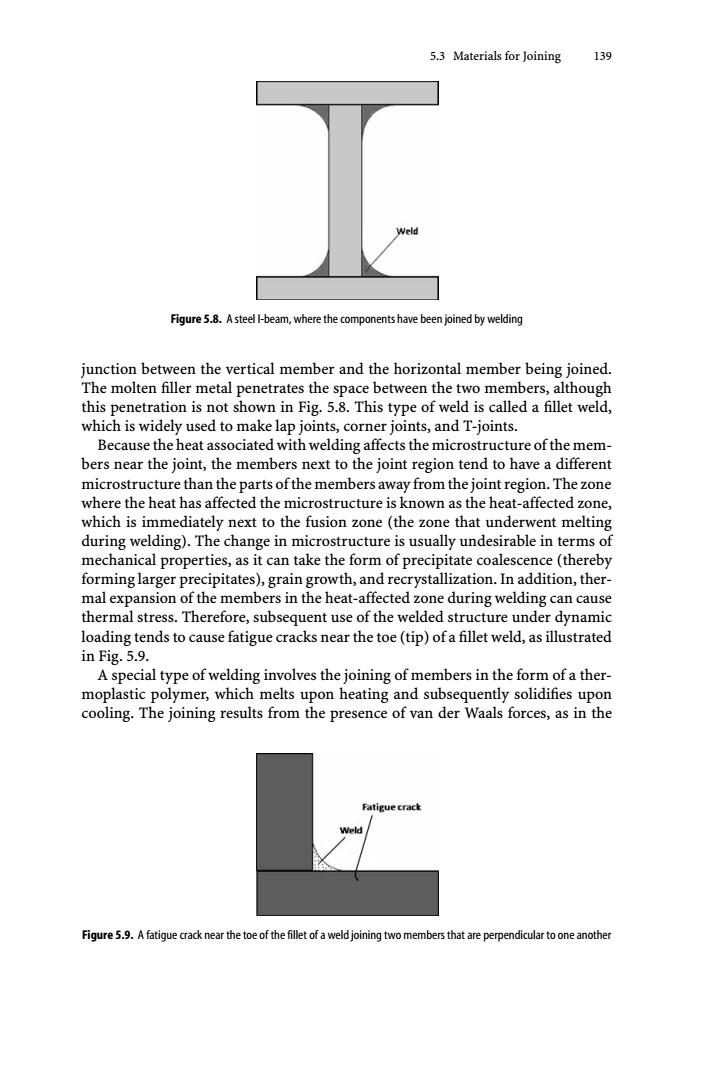正在加载图片...

5.3 Materials for Joining 139 Figure 5.8.A steel I-beam,where the components have been joined by welding junction between the vertical member and the horizontal member being joined. The molten filler metal penetrates the space between the two members,although this penetration is not shown in Fig.5.8.This type of weld is called a fillet weld, which is widely used to make lap joints,corner joints,and T-joints. Because the heat associated with welding affects the microstructure of the mem- bers near the joint,the members next to the joint region tend to have a different microstructure than the parts of the members away from the joint region.The zone where the heat has affected the microstructure is known as the heat-affected zone, which is immediately next to the fusion zone(the zone that underwent melting during welding).The change in microstructure is usually undesirable in terms of mechanical properties,as it can take the form of precipitate coalescence(thereby forming larger precipitates),grain growth,and recrystallization.In addition,ther- mal expansion of the members in the heat-affected zone during welding can cause thermal stress.Therefore,subsequent use of the welded structure under dynamic loading tends to cause fatigue cracks near the toe(tip)of a fillet weld,as illustrated in Fig.5.9. A special type of welding involves the joining of members in the form of a ther- moplastic polymer,which melts upon heating and subsequently solidifies upon cooling.The joining results from the presence of van der Waals forces,as in the Fatigue crack Weld Figure 5.9.A fatigue crack near the toe of the fillet of a weldjoining two members that are perpendicular to one another5.3 Materials for Joining 139 Figure 5.8. A steel I-beam, where the components have been joined by welding junction between the vertical member and the horizontal member being joined. The molten filler metal penetrates the space between the two members, although this penetration is not shown in Fig. 5.8. This type of weld is called a fillet weld, which is widely used to make lap joints, corner joints, and T-joints. Because the heat associated with welding affects the microstructure of the members near the joint, the members next to the joint region tend to have a different microstructure than the parts of the members away from the joint region. The zone where the heat has affected the microstructure is known as the heat-affected zone, which is immediately next to the fusion zone (the zone that underwent melting during welding). The change in microstructure is usually undesirable in terms of mechanical properties, as it can take the form of precipitate coalescence (thereby forming larger precipitates), grain growth, and recrystallization. In addition, thermal expansion of the members in the heat-affected zone during welding can cause thermal stress. Therefore, subsequent use of the welded structure under dynamic loading tends to cause fatigue cracks near the toe (tip) of a fillet weld, as illustrated in Fig. 5.9. A special type of welding involves the joining of members in the form of a thermoplastic polymer, which melts upon heating and subsequently solidifies upon cooling. The joining results from the presence of van der Waals forces, as in the Figure 5.9. A fatigue crack near the toe of the fillet of a weld joining two members that are perpendicular to one another